The Canola Council of Canada is encouraging acreage expansion in the brown soil zone of Saskatchewan.
However, council president Jim Everson says that does not represent a pivot in the council’s strategy for growing the crop.
“We are very much focused on yield,” he said.
That has been the primary objective since the council published its 52 by 2025 Keep it Coming plan in 2014.
“We can grow significantly more canola on about the same number of acres, thereby maximizing the value derived from every seed we plant,” stated the council at that time.
Read Also

Saskatchewan puts crown land auction on hold
Auctions of Saskatchewan crown lease land are once again on hold.
The goal was to more than double yields through genetic and agronomic advancement.
But the yield target of 52 bushels per acre appears unlikely based on the results to date.
This year’s yield is estimated at 39.7 bu. per acre, which is below the 2016-20 average of 41.5 bu. per acre.
Chris Vervaet, executive director of the Canadian Oilseed Processors Association (COPA), recently seemed to suggest that the industry is trying to figure out other ways to increase supply of the crop.
“Although we do rely a lot on productivity gains to increase canola production, there is certainly some potential for increased acreage as well,” he said during a recent webinar hosted by Germination, a seed industry publication.
“There is increasing talk about maybe expanding acres in the brown soil zone of Canada.”
Everson said that is because Viterra, Cargill and Federated Co-operatives Ltd. in partnership with AGT Food and Ingredients, are building new crushing plants in Regina, which is in the dark brown soil zone.
“We expect that is going to draw more interest from growers in putting canola in their rotations,” he said.
Canola rotations are less intense in the brown soil zone than other zones.
The council is attempting to determine the challenges and disease threats in the brown soil zone and to devise a list of best management practices to help farmers overcome those challenges.
Everson said there is no timeline for communicating the results of the research to growers, but he noted that the plants will be coming online in 2024 and 2025.
The council has not established any acreage targets, it just wants to provide helpful information to farmers eager to expand their canola rotations in the brown soil zone.
The research findings could also be applicable for southern Alberta.
Vervaet said there are additional expansion opportunities south of the border in the Pacific Northwest region of the United States and Montana. As well, there is potential to resuscitate winter-seeded canola in Oklahoma.
He said there is a need for more of the crop due to “exploding” demand from North America’s biofuel sector.
COPA is forecasting that the sector could consume 6.5 million tonnes of canola by 2030, up from 1.8 million tonnes in 2020.
That would represent 23 percent of total demand, assuming North American canola production rises to 29 million tonnes by 2030, up from 20 million tonnes in 2020.
The industry is still counting on yield growth through new varieties and better farm practices, such as precision agriculture. It is also hoping for varieties with higher oil content, said Vervaet.
U.S. renewable diesel capacity has quadrupled in the last two years to about eight billion litres per year. It is expected to reach 18 billion litres by 2025.
“This is all happening extremely quickly,” he said.
Canada is expected to have more than four billion litres of capacity by 2027, up from basically nothing today.
There has been a flurry of renewable diesel plant announcements in Canada from the likes of Federated Co-operatives Ltd., Imperial, Parkland, and Tidewater.
“These are companies that traditionally are in the fossil fuel sector, but they are starting to make big announcements and big investments in renewable diesel because there’s an obligation there for them,” said Vervaet.
That obligation is coming in the form of Canada’s new Clean Fuel Regulation, which comes into effect July 1, 2023, replacing the existing federal biofuel mandates.
The objective is to reduce greenhouse gas emissions 15 percent below 2016 levels by 2030.
It is similar to British Columbia’s existing low carbon fuel standard, which is currently targeting a 20 percent GHG emissions reduction by 2030. But that is about to change.
“B.C. is upping the ante,” he said.
“They are looking to make changes to their existing regulation. They’re actually considering perhaps moving to a 30 percent target.”
California, Oregon and Washington all have low carbon fuel standards and nine other states are contemplating legislation.
The legislation is spurring investment in renewable diesel plants, which is in turn prompting investment in new crush facilities across North America.
Canada’s canola crush capacity is forecast to expand by 5.7 million tonnes to 16.8 million tonnes by 2025-26, a 50 percent increase.
U.S. soybean crush capacity is expected to grow by 15 million tonnes over the same time frame, a 25 percent increase.
Vervaet described it as “amazing, never-seen-before” expansion of crush capacity. But he noted that it is all tied to politics.
“These are regulatory markets,” he said.
“Things can change of course because of politics but the politics currently are all about greenhouse gas emission reductions.”
He said he has a “high level of confidence” that these policies are here to stay and that means there will have to be a big increase in canola supply.


















